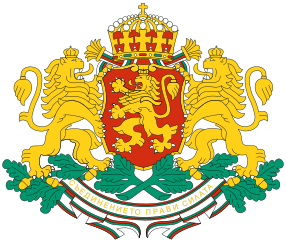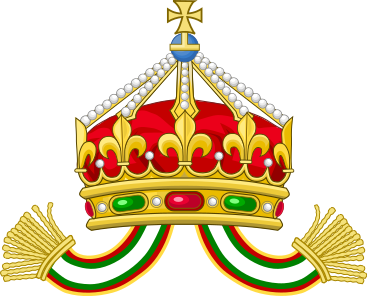Kingdom of
Bulgaria
Царство
България - Tsarstvo Balgariya
The Kingdom of Bulgaria or the Tsardom of Bulgaria
(Bulgarian: Царство България, Tsarstvo
Balgariya; also called Third Bulgarian Tsardom to distinguish it from the First Bulgarian Tsardom and the Second Bulgarian
Tsardom) was a constitutional monarchy, created on 22 September 1908 (old style), as а result of an elevation of the
Bulgarian state to independendent kingdom from tributary principality. This move was taken by Ferdinand who was crowned a
Tsar at the declaration of independence, mainly taken for military plans and more accurately for seeking options for unification
of all lands in the Balkans populated with ethnic Bulgarian majority, seized from Bulgaria and given to the Ottoman Empire
with the Treaty of Berlin.

The state itself
was one of the most actively warring as a proportion of its existence for which was referred to as "the Balkan Prussia",
for several years Bulgaria mobilized army of more than 1 million people from its population of about 5 million and in the
next decade (1910-20) it engaged in three wars - the First, the Second Balkan War and the First World War, but lost both the
Balkan and the World War. After this the Bulgarian army was forbidden to exist by the winning side of the World War and was
actually disbanded and all plans for national unification of the Bulgarian lands failed.

After less than two decades Bulgaria
was again warring for national unification in the Second World War, but was fighting again on the losing side, which was a
fourth lost war. In 1946, the monarchy was abolished, its final Tsar was sent into exile and the Kingdom was replaced by a
People's Republic. Although rarely, it is sometimes referred to as the Third Bulgarian Empire, as in the Middle Ages the term
Tsardom meant an Empire. However, the Third Bulgarian state was internationally recognized as a Kingdom.
Principality of Bulgaria
The Principality
of Bulgaria (Bulgarian: Княжество България,
Knyazhestvo Balgariya) was a constitutional monarchy, vassal of the Ottoman Empire, created at the Treaty of San Stefano on
3 March 1878 (old style) as a result of Russian victory in the Russo-Turkish War of 1877-78. The Тreaty of San Stefano
between the Russian Empire and the Porte (the Ottoman government) had provided a significantly large Bulgarian territory,
encompassing nearly all ethnic Bulgarians in the Balkans and including most of Moesia, Thrace and Macedonia, the coastline
on both the Black Sea, and the Aegean Sea on the Mediterranean. The treaty was said to be preliminary and was pending for
unavoidable revision by the Western great powers, the United Kingdom and Austria-Hungary feared the establishment of a large
Russian client state in the Balkans which might have tipped influential balance on matters concerning the Mediterranean. As
such, the great powers were not willing to accede and the revision of the great powers came in the same 1878 with the Treaty
of Berlin, which took effect only 4 months later than 3 March.

The Treaty of Berlin ruined the Bulgarian principality
and divided its territory into six parts: 1) the Principality of Bulgaria remaining only in Moesia, 2) an autonomous Ottoman
province of Eastern Rumelia was created in the northern part of Thrace, 3) the southern part of Thrace was given to the Ottoman
Empire, 4) Macedonia, the entire was given to the Ottoman Empire, 5 and 6) two more smaller parts were given to Serbia and
Romania. By 1885, Eastern Rumelia succeeded to became again part of the principality after a bloodless revolution. Bulgaria's de facto control of its principality and the surrounding
region made it a successor of the Second Bulgarian Empire and the Bulgarian state after the Liberation from Ottoman rule is
referred to as the Third Bulgarian State. The Principality of Bulgaria ended on 22 September 1908 (old style), when Bulgaria
officially declared independence rejecting all sorts of Ottoman suzerainty and dependence, elevating the principality to Kingdom
of Bulgaria.

Royal House of Bulgaria - Wettin
The current Bulgarian royal family is a line of the Kohary branch of the House of Saxe-Coburg and Gotha
- Wettin, which ruled Bulgaria from 1887 to 1946. The
House of Wettin is a dynasty of German counts, dukes, prince-electors (Kurfürsten) and kings
that once ruled the area of today's German states of Saxony, the Saxon part of Saxony-Anhalt,
and Thuringia for more than 800 years as well as holding at times the kingship of Poland. Agnates
of the House of Wettin have, at various times, ascended the thrones of Great Britain, Portugal,
Bulgaria, Poland, Saxony, and Belgium; of these, only the British and Belgian lines retain their thrones today.
The oldest member of the House of Wettin who is known for certain was Thiedericus (died 982), who was
probably based in the Liesgau (located at the western edge of the Harz). Around 1000, as part
of the German conquest of Slavic territory, the family acquired Wettin Castle, after which they
named themselves.

Wettin
Castle is located in Wettin in the Hosgau on the Saale River. Around 1030, the Wettin family received the Eastern March
as a fief. The prominence of the Wettin family in the Slavic marches caused Emperor Henry IV to
invest them with the March of Meissen as a fief in 1089. The family advanced over the course
of the Middle Ages: in 1263 they inherited the landgraviate of Thuringia (though without Hesse),
and in 1423 they were invested with the Duchy of Saxony, centred at Wittenberg,thus becoming
one of the prince-electors of the Holy Roman Empire.

The family divided into two ruling branches
in 1485 when the sons of Frederick II, Elector of Saxony divided the territories hitherto ruled
jointly. The elder son Ernest, who had succeeded his father as Prince-elector, received the territories assigned to
the Elector (Electoral Saxony) and Thuringia, while his younger brother Albert obtained the March
of Meissen, which he ruled from Dresden. As Albert ruled under the title of "Duke of Saxony",
his possessions were also known as Ducal Saxony.

The
older, Ernestine branch remained predominant until 1547 and played an important role in the beginnings
of the Protestant Reformation. Their predominance ended in the Schmalkaldic War, which pitted
the Protestant Schmalkaldic League against Emperor Charles V. Although itself Protestant, the Albertine
branch rallied to the Empire's cause; Charles V rewarded them by forcing the Ernestines to sign away their rights
to the Electoral title and lands to the Albertines.

The Ernestine line was thereafter restricted
to Thuringia, and its dynastic unity swiftly crumbled. The Albertine Wettin maintained most of
the territorial integrity of Saxony, preserving it as a significant power in the region, and
using small appanage fiefs for their cadet branches, few of which survived for significant lengths
of time. The Ernestine Wettin, on the other hand, repeatedly subdivided their territory, creating
an intricate patchwork of small duchies and counties in Thuringia.

The junior Albertine branch ruled as
Electors (1547-1806) and Kings of Saxony (1806-1918) and also played a role in Polish history:
two Wettin were Kings of Poland (between 1697-1763) and a third ruled the Duchy of Warsaw (1807-1814)
as a satellite of Napoleon. After the Napoleonic Wars, the Albertine branch lost about 40% of
its lands, including the old Electoral Saxony, to Prussia, restricting it to a territory coextensive
with the modern Saxony.

Line of Succession to the Bulgarian Throne
The Bulgarian monarchy was abolished in 1946. The
last reigning monarch was HM Tsar Simeon II of Bulgaria, who is now the currect head of the Bulgarian Royal Family.
The law of succession of the family is agnatic primogeniture. Thus therefore, only males can succeed Simeon II, leading
to the theoretical order of succession to the Bulgarian throne:
- HRH Kardam, Prince of Turnovo, Duke of Saxony(born 2 December 1962)
- HRH Prince Boris of Bulgaria, Duke of Saxony (born
10 October 1997)
- HRH Prince
Beltran of Bulgaria, Duke of Saxony (born 23 March 1999)
- HRH Kyril, Prince of Preslav, Duke of Saxony (born 11 July 1964)
- HRH Prince Tassilo of Bulgaria, Duke of Saxony (born
20 January 2002)
- HRH Kubrat,
Prince of Panagyurishte, Duke of Saxony (born 5 November 1965)
- HRH Prince Mirko of Bulgaria, Duke of Saxony (born 26 April 1995)
- HRH Prince Lukás of Bulgaria, Duke of Saxony (born
15 July 1997)
- HRH Prince
Tirso of Bulgaria, Duke of Saxony (born 3 June 2002)
- HRH Konstantin-Assen, Prince of Vidin, Duke of Saxony (born 5 December 1967)
- HRH Prince Umberto of Bulgaria, Duke of Saxony (born
20 November 1999)

Sovereigns
of Bulgaria - 1878-1946
Family Titles and Styles of the Royal House
The members of this
family bear the titles Prince or Princess of Bulgaria, Duke or Duchess of Saxony, together with the formal appellation of
His or Her Royal Highness.
The Genealogy of The Royal House
FERDINAND Maximilian Karl Leopold Maria Pr of Saxe-Coburg-Gotha,
b.Vienna 26 Feb 1861, d.Coburg 10 Sep 1948, was elected Prince of Bulgaria 7 Jul 1887 and proclaimed himself King (Tsar) of
the Bulgarians 5 Oct 1908; he abdicated on 3 Oct 1918; he m.1st Villa Pianore 20 Apr 1893 Marie Louise Pss of Bourbon-Parma
(Rome 17 Jan 1870-Sofia 31 Jan 1899); m.2d (Catholic) Coburg 28 Feb 1908 (Prot.) Schloß Osterstein 1 Mar 1908 Eleonore
Pss Reuss (Trebschen 22 Aug 1860-Euxinograd 12 Sep 1917)

1a) BORIS III Klemens Robert Maria Pius Ludwig Stanislaus Xaver,
King of the Bulgarians (Sofia 30 Jan 1894-Sofia 28 Aug 1943); m.Assisi 25 Oct 1930 Giovanna Pss of Savoy (Rome 13 Nov 1907-Estoril
26 Feb 2000)
1b) Maria Luisa, b.Sofia 13 Jan 1933; m.1st (civ) Amorbach
14 Feb 1957 (rel) Cannes 20 Feb 1957 (div 1968) Karl Pr zu Leiningen (Coburg 2 Jan 1928-Vered Hagalil, Israel 28 Sep 1990);
m.2d Toronto, Ontario 16 Nov 1969 Bronislaw Chrobok (b.Kattowitz 27 Aug 1933)
2b) SIMEON II, King of the Bulgarians from the death of his
father until he was forced into exile in 1946; b.Sofia 16 Jun 1937; m.(civ) Lausanne 20 Jan 1962 (rel) Vevey 21 Jan 1962 Margarita
Gómez-Acebo y Cejuela (b.Madrid 6 Jan 1935)
1c) Kardam, Pr of Tirnovo, b.Madrid 2 Dec 1962; m.Madrid 11 Jul 1996 Miriam Ungria y López (b.Madrid 2 Sep 1963)
1d) Boris, b.Madrid
10 Oct 1997
2d) Beltran, b.Madrid 23 Mar 1999
2c) Kyrill, Pr of Preslav, b.Madrid 11 Jul 1964; m.Palma de Mallorca 15 Sep 1989 Rosario Nadal y Fuster-Puigdorfila (b.Palma
de Mallorca 22 Oct 1968)
1d) Mafalda-Cecilia Preslavska, b.London 27 Jul 1994
2d) Olimpia Preslavska, b.London
13 Dec 1995
3d) Tassilo, b.20 Jan 2002
3c) Kubrat, Pr of Panagjuriste, b.Madrid 5 Nov 1965; m.Madrid 2 Jul 1993 Carla-Maria Royo-Villanova y Urrestarazu (b.Madrid
3 Jan 1969)
1d) Mirko Panagjurski, b.Madrid 26 Apr 1995
2d) Lucas Panagjurski, b.Madrid 15 Jul 1997
3d) Tirso, b.Madrid 3 Jun 2002

4c) Konstantin-Assen, Pr of Vidin, b.Madrid 5 Dec 1967; m.Madrid
7 Jul 1994 Maria Garcia de la Rasilla y Gortazar (b.Madrid 13 May 1970)
1d) Umberto, b.20 Nov 1999
2d) Sofia, b.20 Nov 1999

5c) Kalina, b.Madrid 19 Jan 1972; m.Borovets, Bulgaria 26 Oct
2002 Antonio Muñoz Valcárcel (b.Sidi Ifni, Morocco 19 Nov 1958)

2a) Kyril Heinrich Franz Ludwig Anton Karl Philipp, Prince Regent
1943-4 (Sofia 17 Nov 1895-executed at Sofia 1 Feb 1945)
3a)
Eudoxia Augusta Philippine Clementine Maria (Sofia 17 Jan 1898-Friedrichshafen 4 Oct 1985)

4a) Nadejda Clementine Maria Pia Majella (Sofia 30 Jan 1899-Stuttgart
15 Feb 1958); m.Bad-Margentheim 24 Jan 1924 Albrecht Eugen Duke of Württemberg (Stuttgart 8 Jan 1895-Schwäbisch-Gmünd
24 Jun 1954) 
